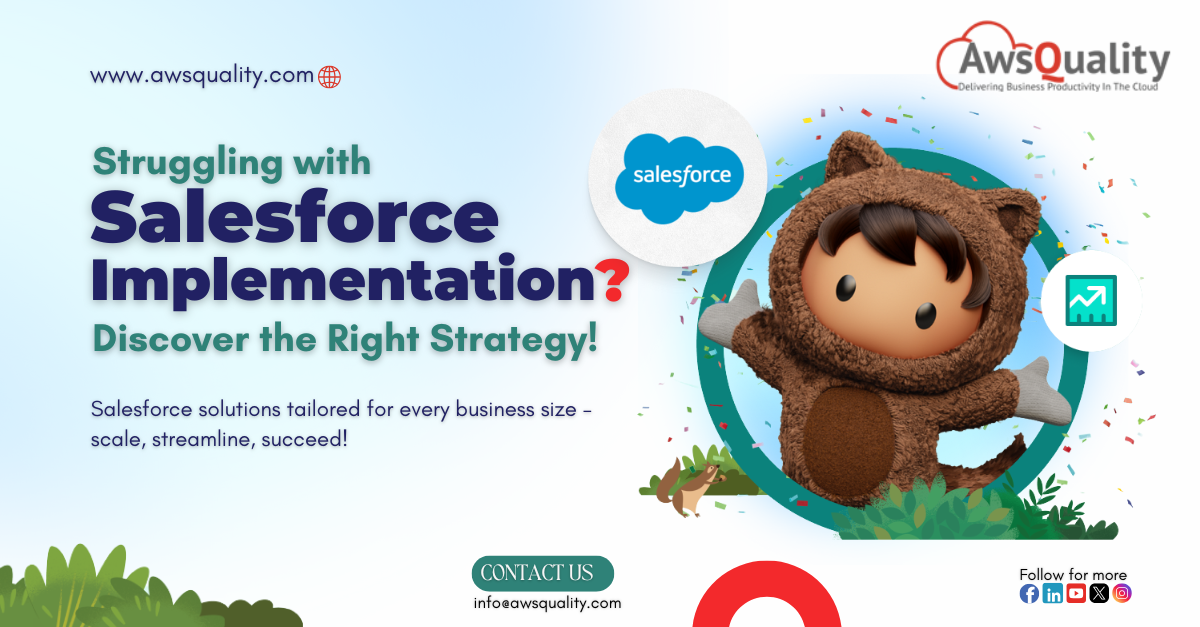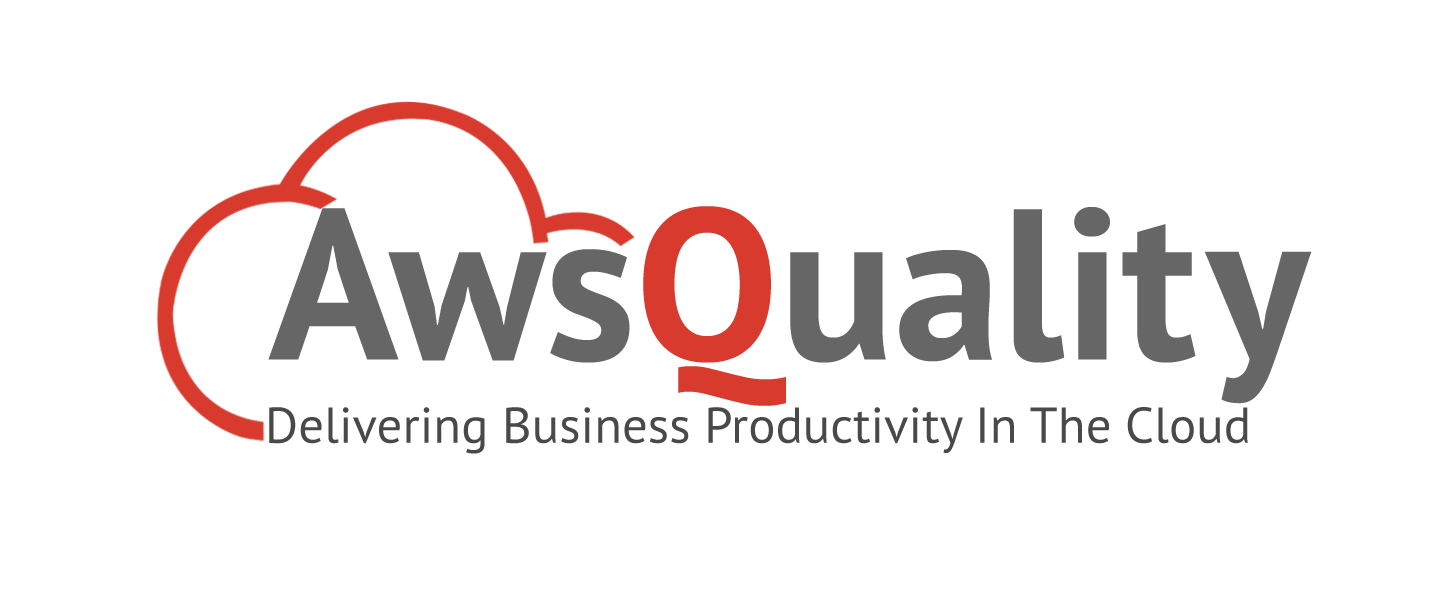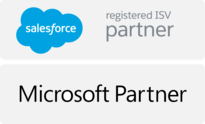
Salesforce CRM has helped revolutionised how businesses manage customer relationships, automate processes and scale operations. No matter if you are a startup, a growing mid-sized organisation, or a large industry player, Salesforce can avail you to your full advantage only when it is rightly implemented. Salesforce is also being increasingly utilised by businesses in Dubai and throughout the Middle East to simplify processes, improve customer relations and grow their business. Still, a little skill and preparation can go a long way toward a successful Salesforce deployment. This is where a Salesforce Consulting Partner like AwsQuality comes in. AwsQuality is eminently known Salesforce Consulting Partner in UAE ensures seamless implementation of CRM as per your strategies.
In this guide, we’ll take you through Salesforce implementation strategies and the key benefits and principles to follow for the deployment of Salesforce according to business size, so your organisation can leverage Salesforce to maximise business growth.
Why Implement Salesforce?
Salesforce is widely adopted across industries due to its ability to:
- Improve customer relationships with personalized insights.
- Automate sales, marketing, and customer service processes.
- Enhance team collaboration through centralised data access.
- Scale business operations with cloud-based solutions.
- Integrate seamlessly with third-party applications for improved functionality.
By following this structured implementation guide, businesses can maximize the benefits of Salesforce and drive long-term success.
Key Benefits of Salesforce Implementation
- Improved Customer Relationship Management – Strengthen customer connections with data-driven insights.
- Data-Driven Decision-Making – Utilise analytics to make informed business choices.
- Automation of Repetitive Tasks – Streamline operations and enhance productivity.
- Seamless Integration with Other Tools – Connect with ERP, marketing, and customer service platforms.
- Scalability and Flexibility – Grow your business with Salesforce’s adaptable solutions.
Step-by-Step Salesforce Implementation Guide
Step 1: Define Business Goals and Requirements
Before implementing Salesforce, businesses must outline clear objectives, such as:
- Enhancing sales tracking and lead conversion.
- Automating customer support and marketing campaigns.
- Leveraging AI-powered analytics for better decision-making.
Step 2: Choose the Right Salesforce Edition
Salesforce offers multiple editions tailored to various business needs:
- Salesforce Essentials – Best for small businesses with basic CRM needs.
- Salesforce Professional – Ideal for growing mid-sized businesses.
- Salesforce Enterprise – Suitable for large organisations requiring advanced features.
- Salesforce Unlimited – Designed for enterprises needing maximum customisation and AI capabilities.
Step 3: Select a Salesforce Consulting Partner
Partnering with an experienced Salesforce consultant ensures a smooth implementation. Companies like AwsQuality, a leading Salesforce Consulting Partner, offer tailored solutions for industries such as retail, finance and healthcare.
Step 4: Customise and Configure Salesforce
Customisation is essential to align Salesforce with business processes. Key customisations include:
- Creating custom fields and objects.
- Implementing workflow automation and AI-driven insights.
- Configuring role-based access control for data security.
Step 5: Data Migration and Integration
Migrating and integrating data into Salesforce requires careful planning:
- Data Cleaning – Remove duplicates and structure data properly.
- Migration Strategy – Use tools like Salesforce Data Loader for bulk transfers.
- Third-Party Integration – Connect Salesforce with ERP, email marketing, and social media tools.
Step 6: Training and User Adoption
Ensuring employees use Salesforce effectively is critical. Businesses should:
- Conduct hands-on training sessions.
- Provide role-specific learning resources.
- Encourage collaboration within Salesforce for better adoption.
Step 7: Testing and Deployment
Before launching Salesforce, businesses must:
- Test all workflows and automation rules.
- Ensure seamless integrations.
- Conduct a pilot rollout before full deployment.
Step 8: Ongoing Support and Optimisation
The process of implementing Salesforce is continuous and calls for frequent upgrades. Businesses should:
- Monitor performance metrics and optimise workflows.
- Gather user feedback to enhance usability.
- Utilise Salesforce consulting partners for advanced customisation and support.
Best Practices for a Successful Salesforce Implementation
A well-executed Salesforce implementation can significantly improve business efficiency, streamline operations, and enhance customer relationships. However, successful implementation requires a strategic approach. Here are the best practices to ensure a smooth transition:
- Involve Key Stakeholders from the Beginning – Engaging decision-makers, IT teams, and end-users early ensures alignment with business objectives and smooth adoption.
- Set Realistic Timelines and Milestones – Establish achievable goals with clear milestones to track progress and avoid delays.
- Regularly Review and Refine Implementation Strategies – Continuous assessment helps optimise workflows and improve system performance.
- Keep Users Engaged Through Ongoing Training – Conduct regular training sessions to ensure users are well-equipped to utilise Salesforce effectively.
- Leverage Salesforce Consultants for Expert Guidance – Working with certified consultants enhances implementation efficiency and maximizes ROI.
Salesforce Implementation for Different Business Sizes
For companies of all sizes, Salesforce provides scalable solutions. Here’s how different organisations can leverage Salesforce effectively:
1. Small Businesses
- Utilise Salesforce Essentials or Professional Edition for cost-effective CRM solutions.
- Focus on essential features like contact management and sales tracking to streamline operations.
- Opt for out-of-the-box configurations to minimise costs and reduce implementation time.
- Automate basic customer interactions and sales tracking to enhance efficiency.
- Use simple reports to monitor business growth and performance.
2. Mid-Sized Businesses
- Leverage Salesforce Professional or Enterprise Editions for enhanced functionalities.
- Implement AI-driven automation to improve marketing and sales efficiency.
- Customise Salesforce to align with evolving business needs and customer demands.
- Integrate Salesforce with marketing, financial, and operational tools for a seamless data flow.
- Develop personalized dashboards to track performance metrics effectively.
3. Large Enterprises
- Opt for Salesforce Unlimited to access advanced AI capabilities and enterprise-grade solutions.
- Deploy multi-department integrations for a unified data flow across the organisation.
- Integrate Salesforce with complex ERP systems for enhanced operational efficiency.
- Utilise advanced analytics and AI-driven forecasting for data-driven decision-making.
- Enable multi-region data handling to support global operations efficiently.
By following these best practices and implementing the right Salesforce edition for your business size, organisations can maximise the platform’s potential and drive long-term success.
Salesforce CRM Implementation Models and Team Structure
Salesforce CRM implementation models refer to different approaches businesses take to deploy Salesforce effectively. Choosing the right model depends on factors such as company size, complexity and internal expertise. Below are some common implementation models:
1. In-House Implementation
The business manages the implementation internally, making it suitable for organisations with experienced Salesforce administrators or developers. Pros: Full control over the process and cost savings on external consultants. Cons: Requires significant expertise and resources.
2. Partner-Assisted Implementation
Businesses work with certified Salesforce implementation partners or consultants. Ideal for companies with complex requirements or limited internal expertise. Pros: Access to expert guidance and faster implementation. Cons: Higher costs due to consultancy fees.
3. Hybrid Implementation
A mix of in-house and external support, where simpler tasks are managed internally while complex integrations are outsourced. Pros: Cost-effective and flexible. Cons: Requires careful coordination between teams.
4. Agile Implementation
Salesforce is implemented in iterative sprints, emphasizing collaboration and adaptability. Pros: Allows for continuous improvement and quick adjustments. Cons: May require more time and resources.
5. Phased Implementation
Salesforce is rolled out in stages, focusing on one department or process at a time. Pros: Minimizes disruptions and allows for iterative improvements. Cons: Longer overall timeline.
6. Big Bang Implementation
Salesforce is deployed across the entire organisation at once. Pros: Faster adoption and immediate impact. Cons: Higher risk of disruptions if not planned thoroughly.
Optimal Salesforce Implementation Team Structure
A well-structured implementation team ensures a smooth and successful Salesforce DevOps or deployment. Key roles include:
- Project Manager – Oversees planning, coordination, and execution, ensuring project milestones are met.
- Salesforce Administrator – Configures and maintains the platform, managing users and permissions.
- Developers – Handle custom workflows, integrations, and automation.
- Data Analyst – Ensures accurate data migration and consistency.
- End-User Representatives – Provide feedback to tailor Salesforce to real-world business needs.
- Integration Specialist – Ensures smooth data flow between Salesforce and other business tools.
- Training Coordinator – Develops and conducts training sessions for users.
- Executive Sponsor – Advocates for the project and aligns it with business goals.
- Consultants (Optional) – Bring expertise for complex implementations.
Salesforce Implementation Challenges and Solutions
Common Challenges:
- Opposition to Change: Workers may be reluctant to embrace new procedures.
- Data Migration Issues: Poor data quality or loss during migration.
- Integration Complexities: Connecting Salesforce with legacy systems.
- Customisation Overload: Excessive modifications can complicate usability.
- User Adoption Problems: Lack of proper training may hinder efficiency.
- Unclear Objectives: Misalignment between features and business needs.
- Budget and Timeline Mismanagement: Unrealistic expectations can lead to rushed implementation.
How to Overcome These Challenges:
- Engage stakeholders early to ensure alignment.
- Allocate time for data migration, testing and training.
- Provide comprehensive user training.
- Continuously monitor system performance and refine as needed.
Successful Salesforce Implementation Stories
1. Jaipur Rugs
A small business that streamlined its sales and service processes using Salesforce. The implementation helped improve customer engagement and operational efficiency. Full Story- (https://www.salesforce.com/in/resources/customer-stories/jaipur-rugs/)
2. REVA University
Though an educational institution, it successfully used Salesforce to manage the student lifecycle, showcasing how even small organisations can enhance workflows. Full Story- https://www.salesforce.com/in/resources/customer-stories/reva-university/
3. Pidilite
By leveraging Salesforce, Pidilite improved relationships with contractors and customers through enhanced communication and operational efficiency.
Salesforce CRM, when implemented strategically, can drive growth, improve workflows, and enhance customer engagement. Selecting the right model and building a strong implementation team are key factors in ensuring success. Full Sorty- https://www.salesforce.com/in/resources/customer-stories/pidilite/
Conclusion,
Salesforce implementation is a transformative step for businesses in the UAE and the Middle East, enabling organisations to streamline operations, improve customer engagement and drive growth. A trusted Salesforce Consulting Partner, like AwsQuality, ensures a seamless transition to Salesforce CRM by leveraging expertise, advanced technology and industry best practices. Whether your business is a startup or an enterprise, following a structured approach to implementation guarantees maximum efficiency and ROI.
Salesforce classifies its partners based on expertise and client success into Registered Partners, Silver & Gold Partners, Platinum Partners and Global Strategic Partners—with AwsQuality holds a strong reputation among Salesforce Consulting Partners, with high ratings on Clutch (AwsQuality Clutch Profile), TrustPilot (AwsQuality TrustPilot) and Crunchbase (AwsQuality Crunchbase).
Frequently Asked Questions
- What is Salesforce implementation?
Salesforce implementation involves setting up, customizing, integrating and optimising Salesforce CRM to align with business processes. - How long does implementation take?
The timeline varies from 4-6 weeks for small businesses to several months for enterprises with complex requirements. - What are the benefits of hiring a Salesforce Consulting Partner?
Expert partners, like AwsQuality, streamline implementation, ensuring higher ROI and efficiency. - How much does Salesforce implementation cost?
Costs depend on project scope, user count, customisations and integrations.




